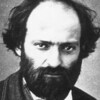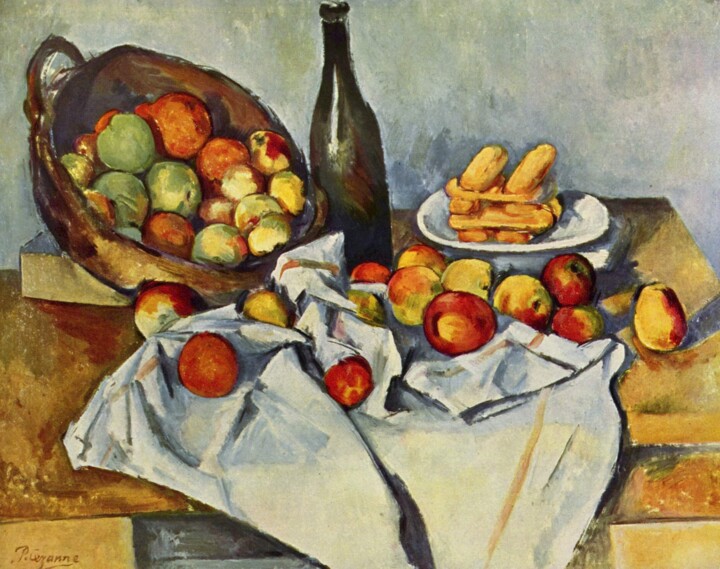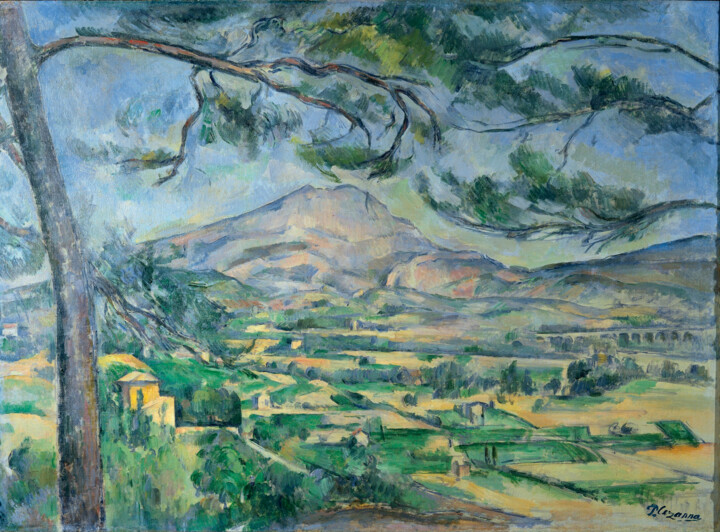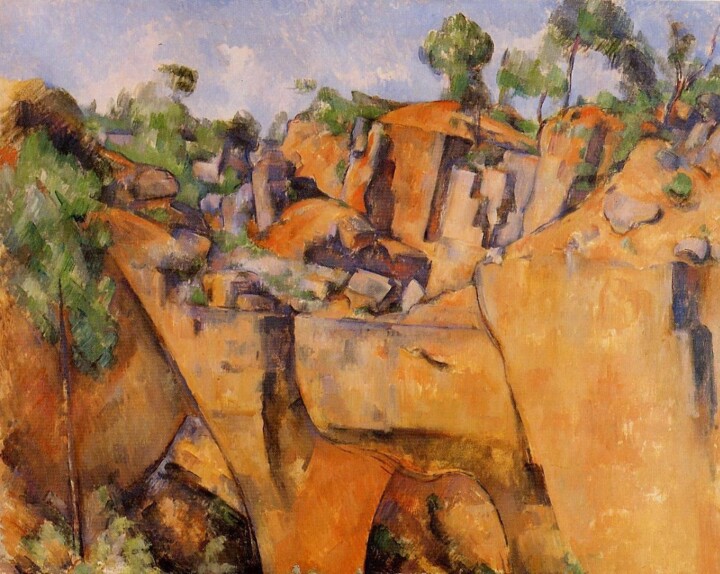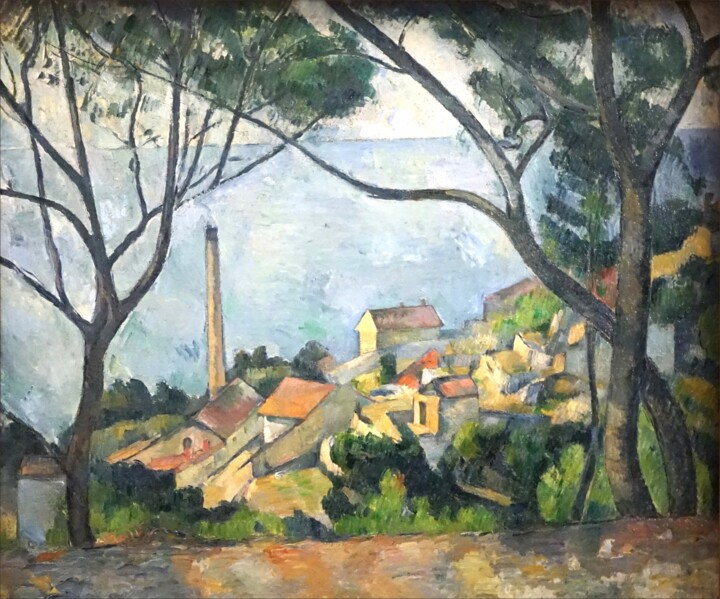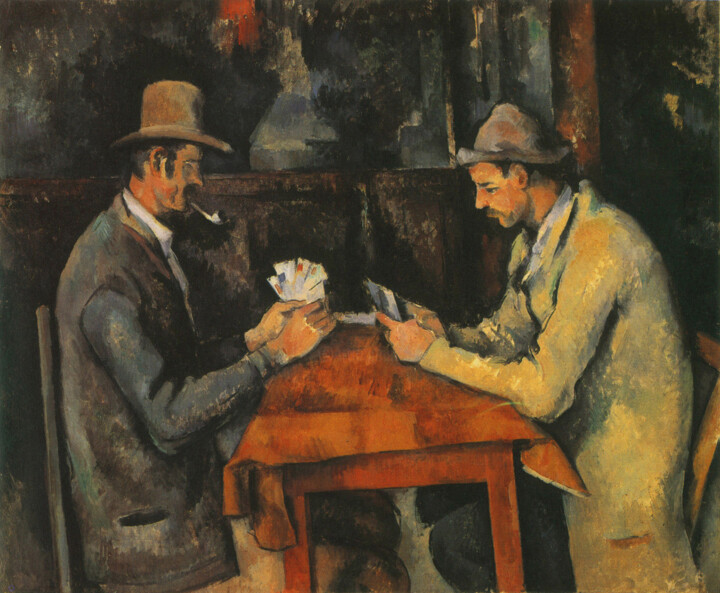Who was Paul Cézanne?
Paul Cézanne was a French artist and painter who lived from 1839 to 1906. He was known as a Post-Impressionist artist whose work introduced new forms of representation and influenced the artistic movements of the early 20th century. Cézanne is often considered the bridge between Impressionism and Cubism. While his early works were influenced by Romanticism and Realism, he developed a new style through studying Impressionism. He changed the traditional rules of academic art by emphasizing the underlying structure of objects and the formal qualities of art, using planes of color and small brushstrokes to create complex fields. Cézanne's work was initially met with incomprehension and ridicule, but fellow artists such as Camille Pissarro and Ambroise Vollard were among the first to appreciate his work. Vollard held the first solo exhibition of Cézanne's work in Paris in 1895, which led to a greater understanding and appreciation of the artist's work. Cézanne's distinctive brushstrokes and use of color modulation principles are highly recognizable, and his influence on art is still felt today, with artists such as Henri Matisse and Pablo Picasso acknowledging him as the "father of us all".
 Paul Cézanne, Self-portrait, 1888-1890. Oil on canvas, 44×36 cm. Ny Carlsberg Glyptotek: Copenhagen.
Paul Cézanne, Self-portrait, 1888-1890. Oil on canvas, 44×36 cm. Ny Carlsberg Glyptotek: Copenhagen.
Key concepts
- Paul Cézanne was not content with the Impressionist belief that painting was merely a reflection of what the artist saw. Instead, he aimed to create a new analytical approach to his artistic practice. Cézanne used the canvas as a platform for recording an artist's visual sensations as they intently and often repeatedly studied a subject. In this way, the canvas acted as a screen to capture the artist's analytical process.
- Cézanne's approach to applying pigments to the canvas was deliberate and systematic. He used methodical brushstrokes as if he were building a picture rather than simply painting it. As a result, his work reflects an architectural ideal where each section of the canvas plays a role in the overall structural integrity of the painting.
- In Cézanne's later paintings, even something as ordinary as an apple would have a pronounced sculptural quality. It was as though he had studied each object in his still lifes, landscapes, and portraits from multiple angles, then reassembled their material properties into a harmony that paralleled nature, rather than simply copying them. This analytical, time-based approach to painting was what inspired the Cubists to view Cézanne as their true mentor.
 Paul Cézanne, A Modern Olympia, 1888-1890. Oil on canvas, 46×55 cm. Paris: Musée d'Orsay.
Paul Cézanne, A Modern Olympia, 1888-1890. Oil on canvas, 46×55 cm. Paris: Musée d'Orsay.
Early years
Paul Cézanne was born on 19 January 1839 in Aix-en-Provence, France, to Louis-Auguste Cézanne, a milliner who later became a banker, and Anne-Elisabeth-Honorine Aubert. Although his parents only married after the birth of Paul and his sister Marie in 1844, they went on to have another child, Rose, in 1854. The Cézanne family originated from Saint-Sauveur in Hautes-Alpes, Occitania. Paul Cézanne was baptized on 22 February at the Église de la Madeleine, with his grandmother and uncle Louis serving as his godparents. Later in life, he became a devoted Catholic. Louis Auguste Cézanne co-founded a banking firm, Banque Cézanne et Cabassol, which flourished throughout Paul's life, providing him with financial security that was rare for artists of his time and resulted in a sizable inheritance. Paul Cézanne had a mother named Anne Elisabeth Honorine Aubert, who lived from 1814 to 1897. She was described as lively and passionate, but also easily offended. Cézanne's mother played a significant role in shaping his perception and outlook on life. He also had two younger sisters, Marie and Rose, and he would attend primary school with them every day. When Paul Cézanne was ten years old, he enrolled in Saint Joseph school in Aix. In his class were Philippe Solari, who would become a sculptor, and Henri Gasquet, whose son Joachim Gasquet would later write a book about Cézanne's life. In 1852, Cézanne moved on to Collège Bourbon in Aix (now Collège Mignet). There, he became friends with Émile Zola and Baptistin Baille, who were both in a lower-level class. The three friends were known as "Les Trois Inséparables" (The Three Inseparables) and spent their free time swimming and fishing in the Arc. They also debated art, read works by Homer and Virgil, and wrote their own poems. Cézanne often wrote his poetry in Latin. Although Zola encouraged him to take poetry more seriously, Cézanne saw it as just a hobby. Cézanne stayed at the college for six years, but was a day scholar during the last two years. In 1857, he began attending the Free Municipal School of Drawing in Aix, where he studied under Joseph Gibert, a Spanish monk, and learned drawing. Paul Cézanne's father wanted him to take over the family's banking business, Cézanne & Cabassol, so he enrolled in the law faculty at the University of Aix-en-Provence in 1859 to study jurisprudence. However, Cézanne did not enjoy his studies and instead preferred to focus on drawing exercises and writing poetry. He also attended evening classes at the École de dessin d'Aix-en-Provence, which was located in the Musée Granet. His teacher was the academic painter Joseph Gibert, and in 1859, Cézanne won second prize in the figure studies course. That same year, his father purchased the Jas de Bouffan estate, which would later become Cézanne's home and workplace for many years. Cézanne was particularly fond of the building and the trees in the estate's park, which he often depicted in his paintings. In 1860, he obtained permission to paint the walls of the drawing room, where he created large murals depicting the four seasons: spring, summer, autumn, and winter. Cézanne humorously signed the paintings as Ingres, a painter whose work he did not appreciate, and even included a date of 1811 on the winter scene, alluding to Ingres' painting Jupiter and Thetis, which was on display in the Musée Granet at the time. Despite objections from his father, who was a banker, Paul Cézanne decided to pursue his artistic development and moved to Paris in 1861. His friend Émile Zola, who was already living in the city, strongly encouraged him to make this decision and convinced him to leave his hesitancy behind. Eventually, Cézanne's father reconciled with him and supported his choice of career, with the condition that he start a regular course of study, as he had given up hope of Paul succeeding him in the banking business. Later on, Cézanne inherited 400,000 francs from his father, which relieved him of all financial worries.
 Paul Cézanne, Pyramid of Skulls, 1901. Oil on canvas, 37 cm × 45.5 cm. Private collection.
Paul Cézanne, Pyramid of Skulls, 1901. Oil on canvas, 37 cm × 45.5 cm. Private collection.
Early Training
Paul Cézanne was mostly self-taught as an artist. He attended evening drawing classes in Aix in 1859 before moving to Paris, where he attempted to enter the École des Beaux-Arts twice but was rejected by the jury. Instead of seeking professional training, Cézanne frequented the Musée de Louvre, where he copied works by famous painters like Titian, Rubens, and Michelangelo. He also visited the Académie Suisse regularly, a studio where young art students could draw from live models for a modest monthly fee. While there, Cézanne met other struggling artists like Camille Pissarro, Claude Monet, and Auguste Renoir, who would later become the founding members of the Impressionist movement. In his early oils, Paul Cézanne used a dark palette and thick layers of impasto, which made his already serious compositions seem even heavier. He focused on color rather than the well-defined shapes and perspectives favored by the French Academy and the jury of the annual Salon, but his works were consistently rejected. Cézanne frequently traveled back to Aix to ask his disapproving father for money. However, in 1870, two events marked a significant shift in Cézanne's painting style. First, he moved to L'Estaque in the South of France to avoid military draft, where he was captivated by the Mediterranean landscape and its abundance of sunlight and vibrant colors. Second, he became closer with Camille Pissarro, a distinguished young Impressionist who persuaded Cézanne to adopt a brighter palette and use smaller and more lively brushstrokes instead of heavy impasto. In L'Estaque, Cézanne painted a series of landscapes featuring the rural houses' architectural shapes, the bright blue sea, and the lively green foliage. In 1872, Paul Cézanne returned to Paris, where he had a son named Paul with his partner, Hortense Fiquet. Although they were not married, they later wed in 1886, shortly after the death of Cézanne's father. Cézanne created over forty portraits of Hortense, as well as some mysterious portraits of their son. In 1873, Cézanne participated in the Salon des Réfusés, an exhibition showcasing works rejected by the official Salon. He exhibited alongside other avant-garde artists such as Édouard Manet, Claude Monet, and Camille Pissarro. However, the critics received the exhibition poorly, and Cézanne was reportedly hurt by the negative reviews. For the next ten years, he mainly painted outside of Paris, in either Aix or L'Estaque, and stopped participating in unofficial exhibitions with groups of artists.
 Paul Cézanne, Mont Sainte-Victoire and the Viaduct of the Arc River Valley, 1882—1885. Oil on canvas, 65.5 cm × 81.7 cm. New York: MET.
Paul Cézanne, Mont Sainte-Victoire and the Viaduct of the Arc River Valley, 1882—1885. Oil on canvas, 65.5 cm × 81.7 cm. New York: MET.
Mature period, late period and death
Cézanne's artistic style was largely influenced by his experimentation with painting from nature, which led him to develop his own unique approaches to art. Instead of depicting fleeting moments, Cézanne focused on the enduring qualities of the objects he observed. He believed that an artist should first understand the essence of a subject, then convey it through forms, colors, and spatial relationships. Cézanne emphasized colors and forms over traditional perspective and paint application techniques taught in the Academy. He was not interested in depicting reality as it was, but in revealing something deeper. In the 1880s, Cézanne reinvented the still life genre by shifting attention from the objects to the potential forms and colors that could be conveyed through their surfaces and contours. Similarly, his portraits, including self-portraits, emphasized the formal and coloristic aspects of the human body rather than the sitter's character. During the final years of his life, Cézanne devoted most of his artistic attention to two main themes. One was the portrayal of Mont Sainte-Victoire, a striking mountain that dominated the rugged, arid landscape of Aix. The other was a series of paintings known as Bathers, which depicted nude figures frolicking in natural surroundings. As he progressed, the Bathers became increasingly abstract in their depiction of form and color. Cézanne died in his family home in Aix on October 22, 1906, after contracting pneumonia. His last years were plagued by severe depression and diabetes, which caused him to become estranged from many of his loved ones.
Famous artworks
 Paul Cézanne, The Bathers, 1898–1905. Oil on canvas, 210.5 cm × 250.8 cm. Philadelphia: Philadelphia Museum of Art.
Paul Cézanne, The Bathers, 1898–1905. Oil on canvas, 210.5 cm × 250.8 cm. Philadelphia: Philadelphia Museum of Art.
The Large Bathers (1898-1906)
The Large Bathers is a prime illustration of Cézanne's endeavor to combine the modern nude with natural surroundings. The human figures are not mythical Greco-Roman deities, but rather ordinary people in various poses, arranged like objects in a still-life composition. The trees and sky intersect to form a pointed arch above the figures. The figures have no particular individuality and are merely arranged for structural purposes. Cézanne's reinterpretation of the traditional Western subject of the female nude is remarkably innovative. The painting's immense size is imposing and confronts the viewer with abbreviated shapes that eventually resolve into the naked limbs of the subjects. This is not quite abstraction, but in such instances, Cézanne has already transcended the representational tradition.
 Paul Cézanne, The Basket of Apples, c. 1893. Oil on canvas, 65 cm × 80 cm. Chicago: Art Institute of Chicago.
Paul Cézanne, The Basket of Apples, c. 1893. Oil on canvas, 65 cm × 80 cm. Chicago: Art Institute of Chicago.
The Basket of Apples (c.1893)
In Cézanne's painting, The Basket of Apples, the objects are placed on a wooden surface that appears to be a table. The apples are positioned inside and outside of a big basket made of wicker, which sits on the edge of the table. A dark bottle is placed in the middle, while a stack of four cookies sits on a white plate to the right of the painting. In the foreground, apples rest on a white cloth, while the background is represented by a light-colored surface. Cézanne's painting, "The Basket of Apples," represents a simplification of natural forms into basic geometric shapes. This allowed the artist to create his own system of visual symbols which he could use to explore his artistic ideas. Cézanne believed that the task of painting was not to replicate nature, but rather to construct a new reality on the two-dimensional surface of the canvas through the use of forms and colors. This idea of space in painting was adopted by other artists, ultimately leading to the Cubist movement. Cézanne argued that a painting should present a harmonious balance created by the artist, and not simply be a copy of nature. Therefore, the artist's role is to observe reality and reconstruct it into a harmonious composition. Art is thus a parallel reality to nature, created by the artist's mind.
 Paul Cézanne, Mont Sainte-Victoire seen from Bellevue, c. 1895. Oil on canvas, 73 cm × 92 cm. Pennsylvania: Barnes Foundation.
Paul Cézanne, Mont Sainte-Victoire seen from Bellevue, c. 1895. Oil on canvas, 73 cm × 92 cm. Pennsylvania: Barnes Foundation.
Mont Sainte-Victoire seen from Bellevue (1895)
Mont Sainte-Victoire seen from Bellevue is a landscape painting created by Paul Cézanne around 1886. The painting depicts the Montagne Sainte-Victoire, a mountain in the southern French region of Provence. Cézanne had a close relationship with the landscape, as he spent a lot of time in Aix-en-Provence where he could see the mountain from his house. He painted the mountain on numerous occasions and included the railway bridge on the Aix-Marseille line at the Arc River Valley in the center-right of the painting. Cézanne's intention was to bring order and clarity to natural scenes without sacrificing the optical realism of Impressionism. The painting's light and colors create a natural pattern that is not imposed on nature, but rather emerges organically.
 Paul Cézanne, The Card Players, 1894–95. Oil on canvas, 47.5 cm × 57 cm. Paris: Musée d'Orsay.
Paul Cézanne, The Card Players, 1894–95. Oil on canvas, 47.5 cm × 57 cm. Paris: Musée d'Orsay.
The Card Players (1890-95)
The painting, Card Players by Paul Cézanne, depicts a scene of two men playing cards in a bistro. However, the subject matter was not important to Cézanne, as he was more interested in simplifying the appearance of reality. The two card players are isolated from the other patrons of the bistro and are possibly peasants, with one of them believed to be named Alexandre, the gardener at the artist's father's estate. The two men are seated at a wooden table with a bottle of wine on it. They are dressed simply but with dignity. The man on the left wears a jacket and a hat and smokes a pipe while evaluating his cards. The younger player on the right is more casually dressed. The painting also shows the wooden wall decorations and a glass door of the bistro.
 Paul Cézanne, Apples and Oranges, c.1900. Oil on canvas, 74 x 93 cm. Paris: Musée d'Orsay.
Paul Cézanne, Apples and Oranges, c.1900. Oil on canvas, 74 x 93 cm. Paris: Musée d'Orsay.
Apples and Oranges (c.1899)
Around 1899, Paul Cézanne created Apples and Oranges, a still life oil painting on canvas. It is one of the last works he completed near the end of his life, and he also produced five other pieces with similar subjects and styles during the same period. The painting is highly recognizable and falls into the category of Modernist paintings that Cézanne completed later in his career, but it is often classified as Impressionism, which Cézanne was an expert in. The Flemish still life tradition also served as inspiration for this painting and the others in the series. Cézanne used everyday objects as the subjects of this piece, including apples and oranges placed in earthenware. The still life features two bowls, each containing a bunch of fruit, as well as other scattered fruits. Amidst the fruits, there is a white jug with colorful floral patterns. A wooden table or stand can be seen underneath a colorful drape, and the fruits rest on a white tablecloth that falls to the ground. The right section of the painting appears brighter than the left, as if a light is shining on one side, providing contrast.
 Paul Cézanne, Sainte-Victoire mountain, 1905-1906. Oil-on-canvas, 60×73 cm. Moscow: Pushkin Museum.
Paul Cézanne, Sainte-Victoire mountain, 1905-1906. Oil-on-canvas, 60×73 cm. Moscow: Pushkin Museum.
Mont Sainte-Victoire (c.1905)
This painting of Mont Sainte-Victoire is one of Cézanne's final works, executed with a more abstract approach to form and color. The mountain is depicted with simplified strokes, resembling a puzzle of various hues. This type of painting proved influential to modernists who sought to break away from traditional representation. Cézanne's mature style gave equal importance to colors and forms, and utilized the juxtaposition of warm and cool colors to construct perspective. Light was no longer an external element, but instead emanated from within the painting. Rather than striving for illusion, Cézanne sought the essence of his subjects, and aimed for two-dimensional truth rather than three-dimensional artifice.
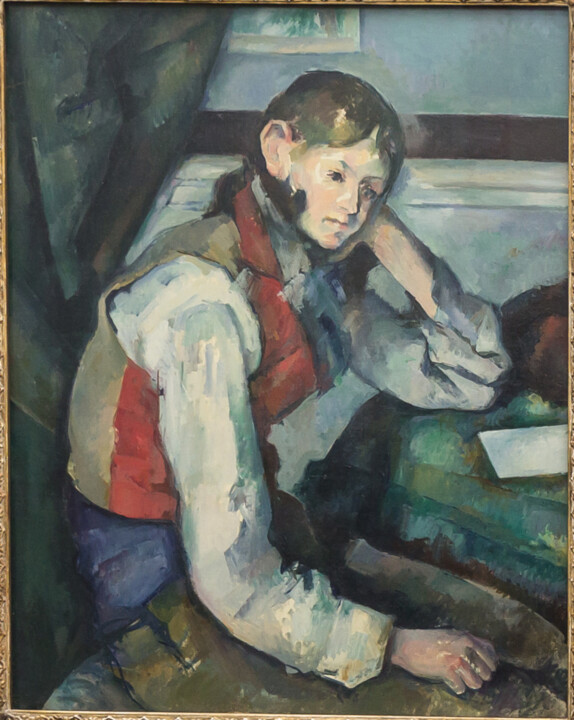 Paul Cézanne, The boy in the red vest, 1888-1890. Oil on canvas, 79.5×64 cm. Zurich: Bührle Foundation.
Paul Cézanne, The boy in the red vest, 1888-1890. Oil on canvas, 79.5×64 cm. Zurich: Bührle Foundation.
The Legacy
Cézanne's unique artistic approach in his late work greatly influenced the younger generation of artists. With his growing reputation, more and more artists were inspired by his innovative vision, including a young Pablo Picasso, who would go on to lead Western painting in a completely new direction. Cézanne's teachings encouraged the new generation to liberate form from color in their art, allowing for a subjective and new pictorial reality rather than mere imitation. This influence continued into the 1930s and 1940s, when Abstract Expressionism emerged as a new artistic manner.
Summary
Paul Cézanne was a highly esteemed French artist who belonged to the Post-Impressionist era. Towards the end of his life, he was recognized for his belief in the importance of painting's material and sculptural roots. Cézanne, also known as the "Master of Aix" after his ancestral home in the South of France, is credited with paving the way for the emergence of twentieth-century modernism, both visually and conceptually. His work is viewed as the vital link between the transient nature of Impressionism and the more tangible artistic movements of Fauvism, Cubism, Expressionism, and even complete abstraction. In hindsight, Cézanne's art is considered essential and powerful.



 Selena Mattei
Selena Mattei
